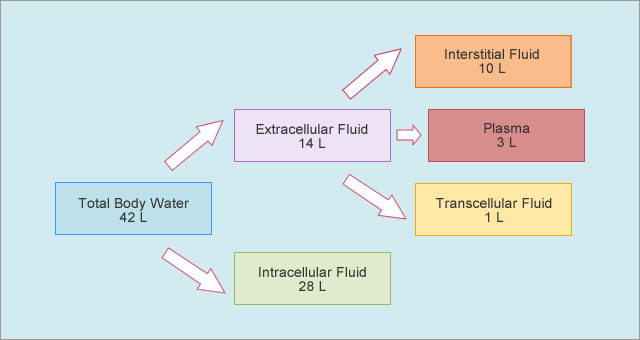The human body mostly consists of water. In healthy lean people, the total body water comprises 50-60% of body weight in men and 45-50% of body weight in women.1
These differences in total body water percentage between men and women are because of women typically having less muscle mass and a greater amount of adipose tissue than men.
In old age, the total body water percentage decreases. This is mostly due to a decrease in muscle mass and an increase in body fat.
The distribution of total body water is divided into two major body fluid compartments:
- Intracellular fluid, which is found inside the cells.
- Extracellular fluid, which is found outside the cells.
The intracellular fluid and extracellular fluid are separated by cell membranes.
The extracellular fluid is further subdivided into the following body fluid compartments:
- Plasma,
- Interstitial fluid surrounds the cells and
- Transcellular fluid is enclosed within epithelial lined spaces (e.g. cerebrospinal fluid, synovial fluid, digestive secretions, peritoneal fluid, intraocular fluid and pleural
fluid).
The plasma and interstitial fluid are separated by the capillary wall.
The diagram below illustrates the values for total body water and fluid distribution based on a 70 kg man and are approximate values.

Note: Numerical data in the diagram is from reference 2.
References:
1. Yaqoob MM. Water, electrolytes and acid-base balance. In: Kumar P, Clark M, editors. Kumar and Clark’s Clinical Medicine. 8th ed. Edinburgh: Saunders Elsevier; 2012:637.
2. Wilkins R, Cross S, Megson I, Meredith D, editors. Important numbers (1). In: Oxford Handbook of Medical Sciences. 2nd ed. Oxford: Oxford University Press; 2011.



